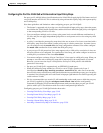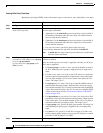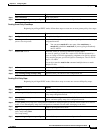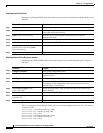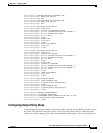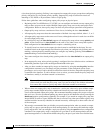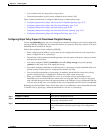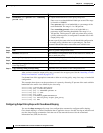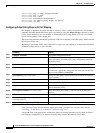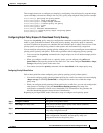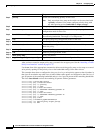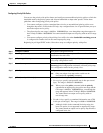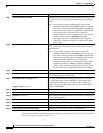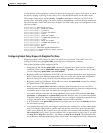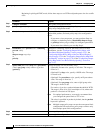
33-55
Cisco ME 3400 Ethernet Access Switch Software Configuration Guide
OL-9639-06
Chapter 33 Configuring QoS
Configuring QoS
Follow these guidelines when configuring class-based shaping:
• Configuring a queue for traffic shaping sets the maximum bandwidth or peak information rate (PIR)
of the queue. In the Cisco ME switch, configuring traffic shaping automatically also sets the
minimum bandwidth guarantee or CIR of the queue to the same value as the PIR.
• You cannot configure CBWFQ (bandwidth) or priority queuing (priority) and traffic (shape
average) for the same class in an output policy map.
• You cannot configure traffic shaping for a traffic class when strict priority (priority without police)
is configured for another class within the output policy-map.
Beginning in privileged EXEC mode, follow these steps to use class-based shaping to configure the
maximum permitted average rate for a class of traffic:
After you have created an output policy map, you attach it to an egress port. See the “Attaching a Traffic
Policy to an Interface” section on page 33-37.
Use the no form of the appropriate command to delete an existing policy map or class map or to delete
a class-based shaping configuration.
This example shows how to configure traffic shaping for outgoing traffic on a Fast Ethernet port so that
outclass1, outclass2, and outclass3 get a maximum of 50, 20, and 10 Mb/s of the available port
bandwidth. The class class-default gets the remaining bandwidth.
Switch(config)# policy-map out-policy
Switch(config-pmap)# class classout1
Switch(config-pmap-c)# shape average 50000000
Switch(config-pmap-c)# exit
Switch(config-pmap)# class classout2
Switch(config-pmap-c)# shape average 20000000
Switch(config-pmap-c)# exit
Switch(config-pmap)# class classout3
Command Purpose
Step 1
configure terminal Enter global configuration mode.
Step 2
policy-map policy-map-name Create a policy map by entering the policy map name, and enter
policy-map configuration mode.
Step 3
class {class-map-name | class-default} Enter a child class-map name or class-default to match all
unclassified packets, and enter policy-map class configuration
mode.
Step 4
shape average target bps Specify the average class-based shaping rate.
For target bps, specify the average bit rate in bits per second. The
range is from 64000 to 1000000000.
Step 5
exit Return to policy-map configuration mode.
Step 6
exit Return to global configuration mode.
Step 7
interface interface-id Enter interface configuration mode for the interface to which you
want to attach the policy.
Step 8
service-policy output policy-map-name Attach the policy map (created in Step 2) to the egress interface.
Step 9
end Return to privileged EXEC mode.
Step 10
show policy-map [policy-map-name [class
class-map-name]]
Verify your entries.
Step 11
copy running-config startup-config (Optional) Save your entries in the configuration file.



